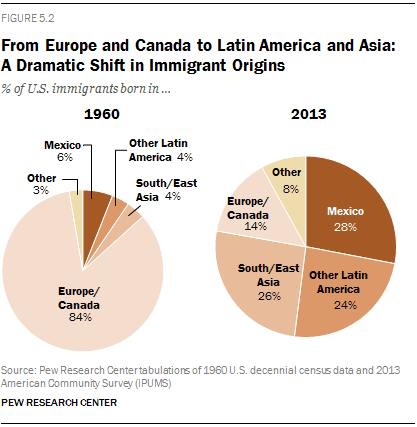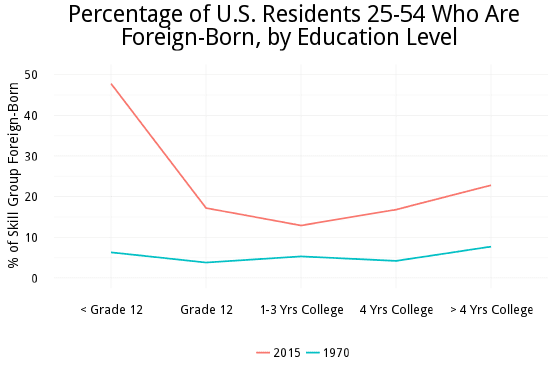Give Us Your High Achievers

America is finally having a conversation it should have had decades ago: exactly whom should we allow into our country? No longer will we maintain the status quo ante, where the subject of our national identity was off the table and the laws were at best selectively enforced. Democrats especially are finding themselves in a bind, as they are unwilling to state publicly that they support open borders but also refuse to enunciate any actual criteria on which we should discriminate—yes, discriminate—among potential newcomers.
Here at TAC, we have a range of opinions on this subject. Editor Robert W. Merry recently explained the difficulties inherent in becoming a majority-minority country—a concern also voiced frequently in the syndicated columns of TAC co-founder Patrick J. Buchanan. Our senior editor Noah Millman takes a more sanguine view of mass immigration, pointing out that his native New York has been made great again (so to speak) while becoming “if anything more polyglot than ever.” In a similar vein, Akhilesh Pillalamari, an editorial assistant, has noted that tribalism is deeply rooted in human nature, that tribal boundaries and national boundaries have not always coincided historically, and that a discrepancy between the two is not always problematic.
This piece is my own two cents. I take very seriously the problems that Merry and Buchanan raise, and I share their dedication to the premise that immigration should serve the national interest. But I see no way for America to turn back from multiculturalism at this point in its history.
My preference, instead, is for an immigration regime that prioritizes highly skilled immigrants. These immigrants contribute more to the economy, compete with the richest American workers rather than the poorest, behave better, and are most likely to share or assimilate to key American cultural norms.
♦♦♦
The problems with multiculturalism cannot be brushed away. As Pillalamarri notes, both the right and the left are uncomfortable with aspects of it. The right does not wish to see its country become nothing more than a collection of disparate groups that happen to share the same territory; liberals endlessly profess their love of diversity but have little tolerance for, say, traditional attitudes toward gender roles or homosexuality.
Pillalamarri explains that in some countries, an extreme form of federalism reigns where, for instance, “family law … is particular to various religious sects.” This degree of segregation is necessary when cultures are not merely different but incompatible. Pillalamarri believes it works just fine. But at the end of the day, few Americans want to live in such a country. Indeed, many of us would not really see it as a country at all.
Yet it isn’t realistic today to pursue a policy of maintaining the nation’s European roots.
In theory, when America finally turned against racial discrimination in the 1960s, immigration policy need not have been affected. One could easily argue that while America had a deep moral obligation to fully integrate the descendants of slaves into civic, economic, and social life, there was no such obligation to people who weren’t even born here. Plenty of countries restrict immigration in a way that maintains a more or less homogeneous domestic population, and hardly anyone gets upset about it.
That’s just not the way it happened. In 1965—just a year after banning employment discrimination —Congress ended discrimination in immigration law as well. Race, religion, and national origin were no longer to be considered. Apparently the bill’s supporters genuinely didn’t expect this to change America’s ethnic makeup, but of course it did.
By 1990, lawmakers were so unconcerned about changing America’s makeup that they did it on purpose, setting up a “diversity” program that to this day hands out up to 50,000 visas every year—by random lottery—to people from countries that don’t send us many immigrants through the normal channels.
Then there is the elites’ decades-long, ongoing collective decision to turn a blind eye to illegal immigration. Add it all up, and this is how the immigrant population has changed, according to the Pew Research Center:

This fractionalization creates real problems, and certain excesses could be rolled back—in particular the lottery and the refusal to control our borders. But at the very least, today’s Americans have completely internalized the conviction that race, religion, and nationality are virtually never the proper grounds on which to make any kind of important decision. Liberals are correct that that’s part of “who we are.”
♦♦♦
Immigrants’ racial makeup wasn’t the only thing to change, however. They also grew in number, driving the foreign-born share of the American population from 5 percent to 13 percent since the ’60s—and all the way to 20 percent if we just look at those of “prime working age,” or 25–54. Immigrants’ educational attainment shifted in relation to that of the typical American worker as well. While foreigners with skills do have special employment-based routes to a green card, family-based preferences (which are not limited to immediate family, enabling “chain migration”) are greater in number. And again, don’t forget those who come illegally.
Basically, immigrants are disproportionately low-skill. Here is a simple way to illustrate that using census data on Americans of prime working age:

All the skill groups are more heavily foreign-born than they were in 1970, just two years after the changes enacted in the 1965 law went into effect. But this is especially pronounced at the very bottom, among those with less than 12 years of education. Incredibly, about half of this group is foreign-born today, meaning there’s an immigrant competitor for every single native dropout. Less than one-tenth of the native adult population falls into this subset—but about a fifth of poor natives do, as do more than one-third of U.S. prisoners, suggesting we should take the plight of these folks very seriously.
(Unless otherwise noted, the rest of the numbers in this piece come from the 2015 American Community Survey, analyzed via this online tool. Free registration required; email me with any questions.)
There’s a lot of debate about how mass immigration of this kind affects the labor market. I won’t go into a lot of detail here, because I did that last month, in my profile of Harvard immigration economist George Borjas. In a nutshell, there are good reasons to think that an influx of low-skill workers is bad for low-skill natives, though there’s also a counter-narrative in which low-skill immigrants “complement” natives, allowing businesses to expand and pushing natives into more communication-intensive jobs.
If immigrants drive down wages, it’s better to focus that blow on the rich than on the poor. And even if complementarity is all it’s cracked up to be, it’s likely most beneficial among the best and the brightest, not the low-skilled. Highly skilled newcomers are further a boon to our tax coffers, simply by virtue of the fact that they make more. In fact, the National Academies estimates that immigrants without a high-school degree, and probably those with a high-school degree but no college as well, are a net fiscal drain, while those with at least a college degree pay far more in taxes than they consume in services.
If we are not going to let in everyone who wants to come, and if we want to choose the immigrants who will most benefit the native population, these are key differences. They will become even more salient as low-wage work is increasingly automated. And there are important non-economic differences as well.
♦♦♦
Take criminality, for instance, an issue that conservatives and liberals alike understand poorly. Conservatives often paint immigrants (especially illegal immigrants) as particularly crime-prone. Liberals respond that immigrants actually have lower crime rates than natives—a statement that is true but misses a very important aspect of the problem, namely that immigrants’ kids are immune to the crime-reducing effects of their parents’ move to an unfamiliar country. In the second generation and higher, some major immigrant groups have notably higher incarceration rates than the average for natives (and especially non-Hispanic white natives), while other groups have much lower rates than natives as a whole. The differences generally correspond to the skill levels of immigrants from those nations.
And it’s not clear that native crime rates are the appropriate benchmark. If one immigrant group has the same crime rate as natives, but another has a lower rate, should we not prefer the latter? What we want here is not assimilation, but lower crime. And it’s basically a sociological constant that higher-educated people commit less crime.
That concept also applies to nonmarital childbearing. We Americans have nothing to brag about in this department, with about 40 percent of children today born out of wedlock. But illegitimacy has been linked to a startlingly wide array of social ills, from poor school performance to arrests. While we won’t and shouldn’t deport every immigrant who becomes a parent without getting married first, we absolutely can focus on admitting the immigrants least likely to make that choice.
The skill filter again comes in handy. It’s well-known that the most educated Americans are still getting married before they have kids; it turns out that’s true for immigrants too. Among foreign-born women with children under 5, about 19 percent of those with less than a 12th-grade education have never been married. This falls to about 4 percent for those with four years of college. (The comparable rates for native mothers, depressingly, are 52 percent and 7 percent.)
There are some areas, however, where we do want assimilation—or if not assimilation, immigrants who already do things our way. We value the English language, for example, not because it’s somehow better than other languages, but because it’s the language we speak. A common language is necessary for real social interaction, and many find it annoying when they can’t even talk to fellow residents of their own country.
The skill filter is yet again a solution. Among the foreign-born in the U.S. age 25–54, 23 percent of those without a 12th-grade education don’t speak English, and another 40 percent don’t speak it “well.” Among those with four years of college, just 2 percent don’t speak English, with another 7 percent not speaking it well.
Highly educated immigrants, like highly educated natives, are also more likely to support free speech, an important trait given the sheer amount of blasphemous entertainment and provocative commentary on offer here in the U.S., not to mention the violence Europe saw in the Charlie Hebdo and “Muhammad cartoon” incidents. According to the General Social Survey (2010–2014), foreign-born Americans 25–54 with more education are substantially more likely than the less educated to say speeches by militarists, homosexuals, racists, anti-religionists, and radical Muslims should be allowed, for example.
One final point to tie all of this together: many of these are not differences that will wash away after a generation or two thanks to the magic of assimilation, because parents pass down their cultures and traits to their children in various ways. Borjas has estimated that the full economic assimilation of Ellis Island immigrants took about a century. Some research shows the assimilation of Hispanic immigrants to stall in the third generation, though this is difficult to measure precisely. And in Albion’s Seed, the historian David Hackett Fischer famously argued that, down to the present day, there are regional cultural differences that can be traced to the way America was originally settled.
♦♦♦
The idea here is not that we need to end the immigration of people with low skills entirely. The foreign-born population currently stands above 40 million; there is plenty of room in such numbers for some variety, and with so many immigrants already here, any change will be gradual. Further, while I have used education as a shorthand for skills here, that is merely a convenience that allows me to sort the data. There is no problem with allowing immigrants to demonstrate their potential with something besides a degree.
What I am saying is that America can have any mix of immigrants it pleases, and that there is no reason for us to have a working-age population that is 20 percent foreign-born overall but nearly 50 percent foreign-born when it comes to those with sub-12th grade educations. Immigrants with the most potential to cause trouble and the least to contribute economically should not be represented in the greatest disproportion.
Americans have stood up and demanded an immigration policy that makes sense and serves the national interest. Prioritizing those with valuable skills is the policy that best fits that description.
Robert VerBruggen is managing editor of The American Conservative. Follow @RAVerBruggen
Comments